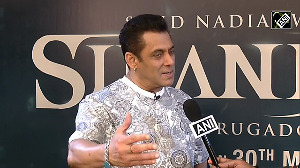Re-industrialising India – the true meaning of “Make in India”, surely – needs more than tinkering with customs rates and a website or two.

Everywhere, there are forced smiles when people talk about the Budget.
It would be awfully bad manners, people seem to think, to criticise Finance Minister Arun Jaitley when he’s done such a good job dealing with last-minute problems such as his party’s wipeout in Delhi, topped off with the nasty fiscal surprise delivered by the 14th Finance Commission (FFC).
But few are excited. What was missing?
Missing was a sense of achievable ambition, and an integrated plan.
Mr Jaitley began his speech by promising a “quantum jump”. Budget 2015: Complete Coverage
But the vision immediately following that promise was one of happy outcomes by 2022 — a picture of an India with jobs and dignity that we have seen painted already and better by the prime minister.
What Mr Jaitley needed to show us was how we are getting there. And on that, he failed.
This was a Budget shaped more by immediate circumstances, by making the best of the situation, than by a coherent, integrated, ideological vision propelling India forward.
Even the big push toward federalism was both half-hearted and not the government’s idea.
First of all, it was the FFC that forced the government’s hand; the FFC was given terms of reference different from all previous commissions.
It was told to think beyond the Plan/non-Plan divide in expenditure, and it did so.
(These updated terms of reference, decided on in end-2012 and released in January 2013, were based on a Planning Commission report from 2011 urging the Budget process to move beyond that artificial distinction.) Forgetting the Plan/non-Plan division meant it sent more money to the states directly.
The Modi government had to accept this devolution.
But it did so half-heartedly, trying to keep control of spending priorities by transferring money away from central assistance to states and towards the Centre’s own Plan spending.
As Rathin Roy explained in this newspaper, while states’ shares of taxes rose by 1.05 per cent of gross domestic product (GDP), they lost central assistance worth 0.75 per cent of GDP.
Mr Jaitley can spin his boss’ commitment to federalism, but the Budget documents tell a different tale.
They clearly say that if 36 paise of every rupee available went to the states last year, only 37 paise of that rupee goes to the states this year.
Worse, there has been no thinking whatsoever on how to move beyond the meaningless and dangerous Plan/non-Plan division of expenditure, the way the FFC did.
This division de-emphasises maintenance and makes this entire country look a little run-down. The end of the Planning Commission was announced on August 15.
What has the government been doing since then, if it is unable to write a Budget in February that takes into account an announcement made in August?
The purpose of the FFC grant was to give states more autonomy over spending; in other words, many of the old centrally sponsored schemes would now become state schemes.
But the Centre has tried to retain some control and some financing over this spending — cutting the expenditure on each scheme by half in many cases.
So what’s the difference from last year?
Well, now the joint secretaries at the Centre running those schemes will have to call state capitals and cajole them into funding them at their end.
This is a ridiculous halfway house. Shut down the programmes, or fund them fully.
If you’re at a moment of transition, give us a road map for each scheme, to one or the other fate, depending on the schemes’ overall importance to your vision of India.
But no such road map is available.
The Budget just reacts vaguely to the end of the Planning Commission and to the FFC award. It does not plan, with a small “p”.
This lack of integrated planning extends to any number of other items.
For example, public infrastructure investment is to be stepped up. But what also matters is how the projects in question will be chosen. Yes, Rs 70,000 crore more investment is planned.
But tell us: Where? On what? Through what? Which roads and highways?
On what basis will they be picked? What backward and forward linkages will be affected?
If this hasn’t been thought through, should we be confident about the money’s effectiveness? Even with the corporate tax cut, the only place a time frame was given, too many questions were left unanswered. The biggest: will tax breaks for units in special economic zones (SEZs) also go?
According to this year’s Budget, they compose about a third of the revenue foregone, thanks to exemptions.
Without removing them, the reduction may not pay for itself.
But is or is the government not a fan of SEZs? If it isn’t, shouldn’t companies be told before they decide to set up in one of them, such as one of those promised by China as part of its “$100-billion” package?
Then there’s the question of subsidies. I’m a fan of transfers, and of plugging leakages.
But when will they start happening? In the last Budget, Mr Jaitley promised an Expenditure Reform Commission that would submit an interim report by this Budget.
That interim report is in. But looking at the Budget numbers – in which non-fuel subsidies are almost completely unchanged! – it is clear the government has chosen to ignore it.
How then will it manage the next step in its attempt to reduce the fiscal deficit? How will expenditure fall enough — especially when next year might be the year that it has to take a one-per-cent-of-GDP hit from the Pay Commission? We need an explanation of how this is going to be done, not just an assurance.
Again: why is there no road map? Finally, the real big-bang reforms are to factor markets, such as labour.
OK, the prime minister wants states to lead on that. But can he not provide political leadership?
Can he not call his own Bharatiya Janata Party chief ministers from Haryana, Rajasthan, Madhya Pradesh, Gujarat and Maharashtra in, and tell them to create a free-market corridor from Gurgaon to Mumbai?
By next year, mobile labour and capital and land, unified and harmonised permissions, exemptions and taxes. Imagine it! If you can, why not Mr Modi and Mr Jaitley?
In the Economic Survey, the chief economic advisor stated that sustained “creative incrementalism” added up to big-bang reforms.
No, it doesn’t. In fact, that’s the exact opposite. A big-bang Budget, as was expected, is not about lots of little reforms. It is about a big integrated shift in policy stance.
It tells us that all the reforms in the Budget are interconnected, that they support and enhance each other, and that they together move, step by step, towards a better and clearly seen future.
That is what we hoped for, and that was what was missing in this Budget.
The problem is that time is not on Mr Jaitley’s side. He had eight months till the next Assembly election this time; but the next Budget will be at a more politically fraught moment.
Meanwhile, over 10 million young Indians will have joined the workforce, and this Budget has very little for them.
Re-industrialising India – the true meaning of “Make in India”, surely – needs more than tinkering with customs rates and a website or two.
It means a comprehensive, all-round effort to change the legal, regulatory and administrative environment.
This is what Budget 2015 was supposed to begin. It did not do so.
Mr Jaitley gave us an 8/10 Budget. Sadly, he did so in a year in which 10/10 was the passing mark.












 © 2025
© 2025